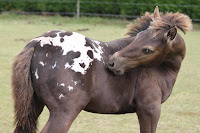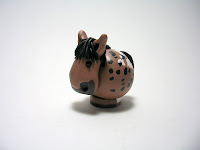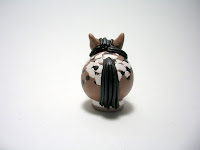Wee Sox was a little more challenging than some others wee horse commissions I've done before. And I loved that! Not only was this a breed I hadn't made before, but Beth asked if I could do a future Wee Sox, based on what he'll look like when he grows into his adult coat.
Appaloosa horses are best known as an American breed and have been featured in many Westerns over the years. They have a very distinctive coat and were bred to enhance the wonderful spotting pattern which covers the body in varying degrees. Although pictured with a chocolate coat and (to quote Beth) a Tina Turner mane, once he grows out of his foal coat, he will be more of a sandy colour with a black mane and tail. The black spots, which aren't clearly visible just now, will become more pronounced.
So I set about creating the future Wee Sox! I started with creating a tan/sandy body by mixing up some clay, and then I worked on the black spots. These are quite wide-ranging over Sox's body, stretching from his hindquarters up to his neck, and they also come in a range of sizes. So I rolled out a very thin sheet of black clay and tore off tiny patches of black, attaching them randomly over the body. Then I gently rolled the body to blend the clay, and I repeated the process with white clay, although this was concentrated mainly on his flanks. So in fact, although it felt like it would be a complicated make, putting it altogether was quite straightforward.
There was no crystal ball-gazing when it came to making Wee Ginny and Wee Bessy - these are beautiful horses, and for Wee Ginny, it was more a case of making sure I mixed up the right shade and conker brown. To get the rich colour, I used the Fimo copper effect clay, which has stood me in great stead for wee horses. It brings a depth to the colour, as well as a great sheen - it's one of my favourite Fimo clays.
So I set about creating the future Wee Sox! I started with creating a tan/sandy body by mixing up some clay, and then I worked on the black spots. These are quite wide-ranging over Sox's body, stretching from his hindquarters up to his neck, and they also come in a range of sizes. So I rolled out a very thin sheet of black clay and tore off tiny patches of black, attaching them randomly over the body. Then I gently rolled the body to blend the clay, and I repeated the process with white clay, although this was concentrated mainly on his flanks. So in fact, although it felt like it would be a complicated make, putting it altogether was quite straightforward.
There was no crystal ball-gazing when it came to making Wee Ginny and Wee Bessy - these are beautiful horses, and for Wee Ginny, it was more a case of making sure I mixed up the right shade and conker brown. To get the rich colour, I used the Fimo copper effect clay, which has stood me in great stead for wee horses. It brings a depth to the colour, as well as a great sheen - it's one of my favourite Fimo clays.
For all three wee horses, I placed their manes so that they were lying on their right. Rather than just lay strands of extruded clay flush against the body and neck, I first of all laid two strands of clay along the line of the neck, and then curled the strands of clay over it, which created a ridge where the neck would be. I think the effect works pretty well.
Thanks again to Beth for commissioning these three gorgeous wee horses - she was delighted with how they turned out, and I'm looking forward to finding out whether the real Sox will bear any resemblance to Wee Sox in the future!








No comments:
Post a Comment